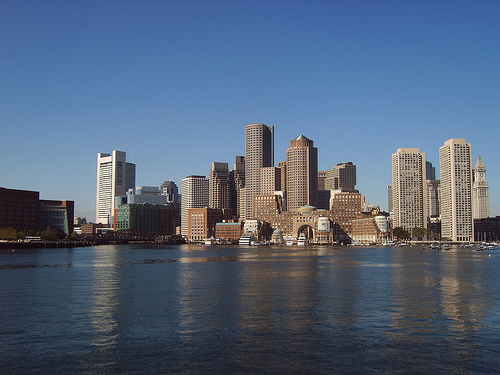 Boston has mandated the nation’s first green building code for private projects.Photo courtesy Willem van Bergen via FlickrAdapted and cross-posted from Climate Progress.
Boston has mandated the nation’s first green building code for private projects.Photo courtesy Willem van Bergen via FlickrAdapted and cross-posted from Climate Progress.
Humans have officially made their home in the concrete jungle. Ours is the first generation in which most of the world’s population lives in cities.
With 6 billion people on the planet, and 2 billion more expected within 20 years, the race to our cities and the slums and vast sprawl surrounding some of them will only accelerate. Already, our metropolises — 21 already have populations of 10 million or more — consume about three-quarters of the world’s energy, releasing vast quantities of the greenhouse gases (GHGs) that warm the planet.
Protecting our climate, in other words, means redefining what urban means. Yet much coverage of climate action dismisses local and state government actions in favor of splashy (or, recently, dismal) international announcements and would-be efforts.
That’s a mistake, suggests the Pew Foundation, which credits cities and local governments for having cut more than 23 million tons of greenhouse gasses — equivalent to the emissions produced by 1.8 million households — in 2009 alone. In fact, if just local governments in the U.S. meet their emissions targets, the country will be well on its way to meeting the Obama administration’s official emissions target of 17 percent below 2005 levels within a decade.
“Generally, cities are the place where it’s going to happen,” says K.C. Boyce, who oversees the U.S. membership program for ICLEI USA – Local Governments for Sustainability, an organization of local governments worldwide dedicated to urban sustainability and lowering GHG emissions. The group is betting that cities, including the 600 on ICLEI’s rosters in the U.S., will lead their nations toward a low-carbon future. “Land use, zoning, and transportation are the nexus that has the potential to have a real impact because it’s about where we live, how we live, and how we travel,” says Boyce.
Cities have a unique power to drive immediate change involving issues such as public transportation, but they also can help influence prosaic long-term land use planning (think about all those interminable city council meetings) to realize truly sustainable cities. No futuristic visions of cities are needed. For now, the reality is more mundane: asphalt recycling and better insulation in buildings, timers for coffee makers and telecommuting, light sensors, and water conservation.
Local governments are tackling GHG emissions in any way they can: Boston, for instance, has mandated the nation’s first green building code for private projects. In Gainesville, Fla., the city utility pays a premium for solar power from peoples’ homes fed back into the grid. In Babylon, N.Y., homeowners are eligible for loans to make their homes more efficient, and those loans are entirely repaid through cost savings in their power bills.
But to create low- or zero-emission cities — among the only ways to avoid dangerous climate change if the objective is to cut GHG emissions 80 percent below 1990 levels by 2050, the target set by the Intergovernmental Panel on Climate Change — more revolutionary changes are needed.
At least 1,000 cities in the U.S. and around the world are adopting targets and taking action, says ICLEI. Cities are cooperating internationally, offering financial incentive programs for clean power plants and home retrofits, and planning growth and emission cuts as much as half-a-century down the road.
Groups such as the U.S. Conference of Mayors Climate Protection Center, the Global Carbon Project’s Urban and Regional Carbon Management Initiative, and a constellation of universities’ engineering, urban planning, and climate science and policy departments have sprung up to support these efforts. This bottom-up approach seems to be gaining steam, despite the inability of climate talks in Washington or internationally to produce a binding climate strategy.
A big question, says Professor Jim Hall, a civil engineer at the U.K.’s Newcastle University and the Tyndall Center for Climate Change Research, involves just how to manage a system as complex as a modern city.
“There are no silver bullets here,” Hall emphasizes. “One needs to put together strategic portfolios of measures. We are trying to make the case by taking an integrated approach to the built environment, infrastructure, and land use, bringing those three areas together. Timely decisions now can get us on a more sustainable track.”
Breakthroughs to cut emissions ever more steeply, he argues, will require demonstrations in the urban laboratory. Policies and technologies can be combined in variations across the world, and the best will show the way in the future, he says; no other forum has quite the same concentration of human wealth and talent. “Cities are centers of creativity,” Hall says. “The rate of growth and change within cities provides real opportunities for innovation for climate protection.”
 Chicago has won praise for promoting biking and walking.Photo courtesy Tom Gill via FlickrCities’ climate honor roll
Chicago has won praise for promoting biking and walking.Photo courtesy Tom Gill via FlickrCities’ climate honor roll
ICLEI USA has compiled a list of cities taking action to reduce their GHG emissions. Take a look:
Residential Green Building Code: Santa Fe, N.M.
The Santa Fe Residential Green Building Code adopted in 2009 sets a high energy efficiency standard for all new residential construction, with larger homes required to meet increasingly stringent energy use performance benchmarks (homes of more than 8,000 heated square feet are actually required to produce the same amount of energy that they expect to use).
Compressed Workweek: Asheville, N.C.
In 2008, Asheville cut energy demand and commuting costs for employees through a compressed work week. Instead of a traditional schedule, all staff (except senior management) work 10 hours per day, four days each week. The city cut energy use in public works buildings by 13 percent and estimated savings of 249 metric tons of CO2 equivalent per year.
Solar Feed-In Tariff: Gainesville, Fla.
Gainesville Regional Utilities became the first municipally-owned and -operated utility in the U.S. to enact a solar feed-in tariff. Gainesville will pay 32 cents per kilowatt hour (kWh) for 20 years for power generated by solar electric systems installed in 2009 and 2010.
Promoting Cycling and Walking: Chicago, Ill.
The City of Chicago has drafted its pedestrian and bike plan, including recommendations for a 500-mile bikeway network, street safety improvements for cyclists, and 5,000 new bike racks.
Biogas to Energy: Columbia, Mo.
Columbia was Missouri’s first city to have a voter-approved renewable energy standard requiring renewable sources for the city’s energy supply. To help meet its goal, the Columbia Biogas Energy Plant came online in June 2008. By converting landfill gas to energy from its decomposing waste, the city can generate 2.1 megawatts of renewable power, enough to power 1,500 city homes.
Wastewater Treatment: Houston, Texas
Since 2006, the City of Houston has tested 20 floating solar-powere
d reservoir circulators (SolarBees), designed to improve public drinking water quality and reduce water treatment costs by replacing energy-intensive treatment methods. Researchers point to notable improvements in water clarity and other water quality indicators such as pH, total organic carbon (TOC), and turbidity in waters entering the treatment plant.
Solar power: Santa Monica, Calif.
The City of Santa Monica’s Community Energy Independence Initiative establishes a net zero [emissions] energy goal for the city by 2020. It aims to produce as much electricity as consumed through energy efficiency measures and solar power. Solar Santa Monica provides free-of-charge energy efficiency and solar assessments for residential and commercial property owners and pre-qualified contractors.



